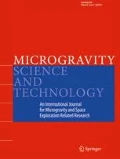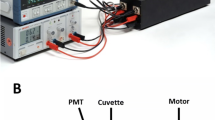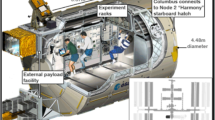Abstract
In order to prepare and support space experiments, 2D and 3D clinostats are widely applied to study the influence of simulated weightlessness on biological systems. In order to evaluate the results a comparison between the data obtained in simulation experiments and in real microgravity is necessary. We are currently analyzing the gravity-dependent behavior of the protists Paramecium biaurelia (ciliate) and Euglena gracilis (photosynthetic flagellate) on these different experimental platforms. So far, first results are presented concerning the behaviour of Euglena on a 2D fast rotating clinostat and a 3D clinostat as well as under real microgravity conditions (TEXUS sounding rocket flight), of Paramecium on a 2D clinostat and in microgravity. Our data show similar results during 2D and 3D clinorotation compared to real microgravity with respect to loss of orientation (gravitaxis) of Paramecium and Euglena and a decrease of linearity of the cell tracks of Euglena. However, the increase of the mean swimming velocities, especially during 3D clinorotation (Euglena) and 2D clinorotation of Paramecium might indicate a persisting mechanostimulation of the cells. Further studies including long-term 2D and 3D clinostat exposition will enable us to demonstrate the qualification of the applied simulation methods.
Similar content being viewed by others
References
Briegleb, W.: Some quantitative aspects of the fast-rotating clinostat as a research tool. ASGSB Bull., vol. 5, p. 23 (1992).
Cogoli, M.: The fast-rotating clinostat: a history of its use in gravitational biology and a comparison of ground-based and flight experiment results. ASGSB Bull., vol. 5, p. 59–68 (1992).
Häder, D.-P., Hemmersbach, R., Lebert, M.: Gravity and the behaviour of unicellular organisms. Cambridge University Press (2005).
Hoson, T., Kamisaka, S., Masuda, Y., Yamashita, M., Buchen, B.: Evaluation of the three-dimensional clinostat as a simulator of weightlessness. Planta, vol. 203, p. 187 (1977).
Schwarzenberg, M., Pippia, P., Meloni, M. A., Cossu, G., Cogoli-Greuter, M., Cogoli, A.: Signal transduction in T lymphocytes — A comparison of the data from space, the free fall machine and the random positioning machine. Adv. Space Res., vol. 24, p. 793 (1999).
Hemmersbach-Krause, R., Briegleb, W., Häder, D.-P., Vogel, K., Grothe, D., Meyer, I.: Orientation ofParamecium under the conditions of weightlessness. J. Euk. Microbiol., vol. 40, p. 439 (1993).
Vogel, K., Hemmersbach-Krause, R., Kühnel, C., Häder, D.-P.: Swimming behavior of the unicellular flagellate,Euglena gracilis, in simulated and real microgravity. Microgravity Science Technology, vol. 4, p. 232 (1993).
Hemmersbach-Krause, R., Briegleb, W., Vogel, K., Häder, D.-P.: Swimming velocity ofParamecium under the conditions of weightlessness. Acta Protozool., vol. 32, p. 229 (1993).
Häder, D.-P., Vogel, K., Schäfer, J.: Responses of the photosynthetic flagellate,Euglena gracilis, to microgravity. Microgravity Science Technology, vol. 2, p. 110 (1990).
Häder, D.-P., Porst, M., Tahedl, H., Richter, P., Lebert, M.: Gravitactic orientation of the flagellateEuglena gracilis. Microgravity Science Technology, vol. 10, p. 53 (1997).
Batschelet, E.: Circular Statistics in Biology. Academic Press, London, New York, (1981).
Strauch, S. M., Hemmersbach, R., Seibt, D., Schuber, M., Häder, D.P.: Behavior of gravisensitive cells on 2D and 3D clinostats. J. Gravitational Physiol., vol. 12, p 259 (2005).
Author information
Authors and Affiliations
Corresponding author
Rights and permissions
About this article
Cite this article
Hemmersbach, R., Strauch, S.M., Seibt, D. et al. Comparative studies on gravisensitive protists on ground (2D and 3D clinostats) and in microgravity. Microgravity Sci. Technol 18, 257–259 (2006). https://doi.org/10.1007/BF02870423
Issue Date:
DOI: https://doi.org/10.1007/BF02870423




